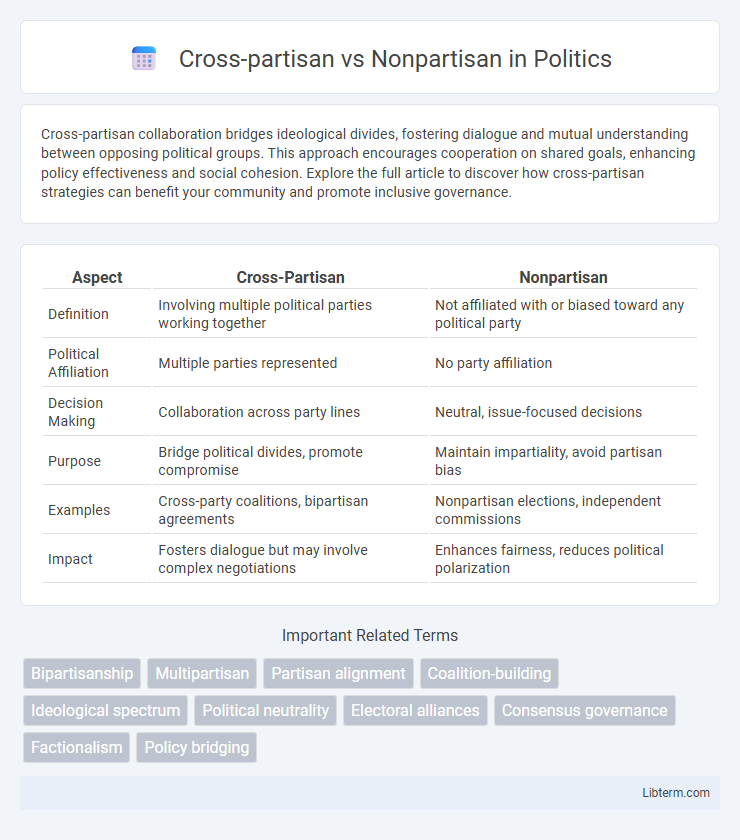Cross-partisan collaboration bridges ideological divides, fostering dialogue and mutual understanding between opposing political groups. This approach encourages cooperation on shared goals, enhancing policy effectiveness and social cohesion. Explore the full article to discover how cross-partisan strategies can benefit your community and promote inclusive governance.
Table of Comparison
| Aspect | Cross-Partisan | Nonpartisan |
|---|---|---|
| Definition | Involving multiple political parties working together | Not affiliated with or biased toward any political party |
| Political Affiliation | Multiple parties represented | No party affiliation |
| Decision Making | Collaboration across party lines | Neutral, issue-focused decisions |
| Purpose | Bridge political divides, promote compromise | Maintain impartiality, avoid partisan bias |
| Examples | Cross-party coalitions, bipartisan agreements | Nonpartisan elections, independent commissions |
| Impact | Fosters dialogue but may involve complex negotiations | Enhances fairness, reduces political polarization |
Understanding Cross-Partisan and Nonpartisan Approaches
Cross-partisan approaches involve collaboration between individuals or groups representing different political parties or ideologies, fostering dialogue and compromise to address complex policy issues. Nonpartisan methods prioritize neutrality, avoiding alignment with any political party to ensure unbiased decision-making and promote inclusivity in governance or research contexts. Understanding these approaches is essential for designing effective political strategies, facilitating bipartisan cooperation, and enhancing impartiality in public administration or electoral processes.
Historical Context of Political Collaboration
Cross-partisan efforts historically emerged as strategic alliances between different political parties aiming to address urgent national issues, such as the formation of Civil Rights legislation in the 1960s United States. Nonpartisan collaboration, often seen in local government and judicial systems, prioritizes unbiased decision-making free from party influence, exemplified by many city councils and school boards established in the early 20th century during Progressive Era reforms. These distinct approaches reflect evolving strategies for political collaboration shaped by historical contexts of partisanship, governance needs, and public trust restoration.
Defining Cross-Partisan Engagement
Cross-partisan engagement involves collaboration and communication between individuals or groups with differing political ideologies, aiming to bridge divides and foster mutual understanding across party lines. This approach contrasts with nonpartisan engagement, which operates without allegiance to any political party, focusing instead on neutral, unbiased participation in civic or social initiatives. Defining cross-partisan engagement emphasizes active dialogue, negotiation, and cooperation among partisan groups to address shared challenges despite ideological differences.
What Does Nonpartisan Really Mean?
Nonpartisan refers to an approach or position that is not affiliated with or influenced by any political party, emphasizing impartiality and objectivity. In contrast to cross-partisan efforts, which involve collaboration between different political parties, nonpartisan activities aim to remain independent of party politics altogether. This distinction ensures decisions and actions are guided by unbiased analysis and public interest rather than party agendas.
Key Differences Between Cross-Partisan and Nonpartisan Models
Cross-partisan models involve collaboration between individuals or groups from different political parties to achieve mutual goals, emphasizing dialogue and compromise across partisan lines. Nonpartisan models operate without affiliation to any political party, focusing on objective decision-making and governance based on issues rather than party ideology. The key difference lies in cross-partisan engagement actively includes multiple party perspectives, while nonpartisan approaches avoid party influence entirely to maintain neutrality.
Benefits and Challenges of Cross-Partisan Strategies
Cross-partisan strategies foster collaboration across political divides, enhancing policy innovation and promoting democratic resilience by incorporating diverse perspectives. Benefits include increased trust among stakeholders and more comprehensive solutions that address broader societal needs. Challenges involve navigating deep ideological differences, managing potential conflicts, and ensuring effective communication to maintain productive partnerships.
The Role of Nonpartisan Organizations in Democracy
Nonpartisan organizations play a crucial role in democracy by providing unbiased information and promoting civic engagement without political influence, enhancing electoral transparency and voter education. These organizations facilitate inclusive participation by focusing on common democratic values rather than party agendas, thereby fostering trust and collaboration among diverse citizen groups. Their nonpartisan stance helps mitigate polarization, ensuring that democratic processes reflect the collective interests of the population rather than partisan divisions.
Case Studies: Cross-Partisan vs Nonpartisan Initiatives
Case studies of cross-partisan initiatives reveal collaboration between diverse political groups aiming for consensus-driven solutions on contentious issues such as climate change and criminal justice reform. Nonpartisan initiatives prioritize objectivity and neutrality, often led by independent organizations or public agencies, emphasizing data-driven decision-making to foster public trust. Comparative analysis shows cross-partisan efforts enhance dialogue and compromise, while nonpartisan approaches strengthen credibility and policy implementation efficacy.
Public Perceptions and Misconceptions
Public perceptions often conflate cross-partisan and nonpartisan approaches, leading to misconceptions about their objectives and outcomes. Cross-partisan efforts involve collaboration between opposing political parties to achieve consensus, whereas nonpartisan endeavors avoid party labels to ensure neutrality and inclusivity. Understanding these distinctions clarifies debates on political cooperation and democratic engagement in media coverage and civic education.
Future Trends in Political Collaboration
Cross-partisan collaboration, where members from different political parties work together, is gaining momentum as a strategy to overcome polarization and address complex policy issues. Nonpartisan approaches, which emphasize impartiality and consensus-building without party bias, continue to be crucial in local governance and nonprofit sectors. Future trends indicate a hybrid model combining cross-partisan dialogue with nonpartisan frameworks to enhance trust, foster innovative solutions, and improve legislative effectiveness.
Cross-partisan Infographic

 libterm.com
libterm.com